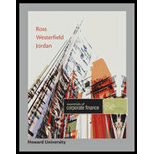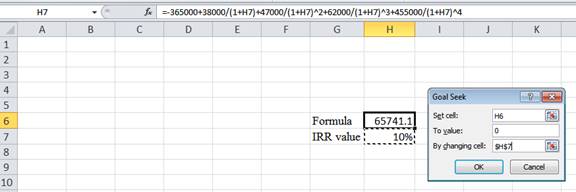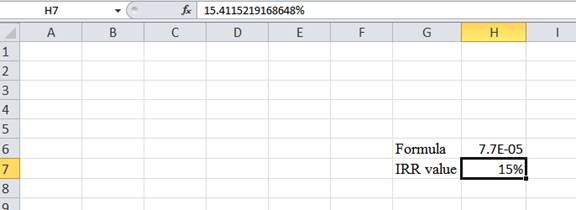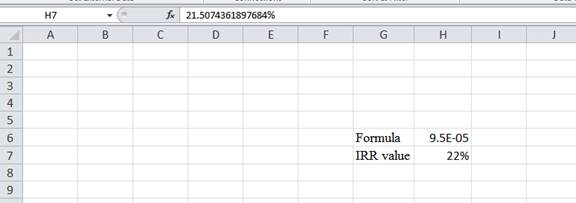
a)
To compute: The payback period and the investment that must be selected.
Introduction:
Capital budgeting is a process where a business identifies and assesses the potential investments or expenses that are larger (in general).
a)
Answer to Problem 15QP
Here, Project B must be accepted as it pays back sooner than Project A.
Explanation of Solution
Given information:
The cash flows for two mutually exclusive projects are $38,000, $47,000, $62,000, $455,000 for Project A for year 1, year 2, year 3, and year 4respectively. Project A has an initial investment of -$365,000. The cash flows of Project B are $20,300, $15,200, $14,100, and $11,200 for year 1, year 2, year 3, and year 4respectively. The initial investment for Project B is -$40,000. The
Formula to compute the payback period of a project:
Compute the payback period of Project A:
Hence, the payback period is 3.47 years for Project A.
Compute the payback period of Project B:
Hence, the payback period is 2.29 years for Project B.
b)
To compute: The NPV (
Introduction:
Capital budgeting is a process where a business identifies and assesses the potential investments or expenses that are larger (in general).
b)
Answer to Problem 15QP
Here, Project A must be accepted as the NPV is higher in Project A.
Explanation of Solution
Given information:
The cash flows for two mutually exclusive projects are $38,000, $47,000, $62,000, $455,000 for Project A for year 1, year 2, year 3, and year 4respectively. Project A has an initial investment of -$365,000. The cash flows of Project B are $20,300, $15,200, $14,100, and $11,200 for year 1, year 2, year 3, and year 4respectively. The initial investment for Project B is -$40,000. The rate of return is 13%.
Formula to calculate the NPV:
Calculate the NPV for Project A:
Hence, the NPV for Project A is $27,465.34385.
Calculate the NPV for Project B:
Hence, the NPV for Project B is $6,509.074.
c)
To compute: The
Introduction:
Capital budgeting is a process where a business identifies and assesses the potential investments or expenses that are larger (in general).
c)
Answer to Problem 15QP
Here, Project B must be accepted as the IRR is higher in Project B.
Explanation of Solution
Given information:
The cash flows for two mutually exclusive projects are $38,000, $47,000, $62,000, $455,000 for Project A for year 1, year 2, year 3, and year 4respectively. Project A has an initial investment of -$365,000. The cash flows of Project B are $20,300, $15,200, $14,100, and $11,200 for year 1, year 2, year 3, and year 4respectively. The initial investment for Project B is -$40,000. The rate of return is 13%.
Equation of the IRR of Project A:
Compute IRR for Project A using a spreadsheet:
Step 1:

- Type the equation of NPV in H6 in the spreadsheet and consider the IRR value as H7.
Step 2:

- Assume the IRR value as 10%.
Step 3:

- In the spreadsheet, go to data and select What-if analysis.
- In What-if analysis, select Goal Seek.
- In “Set cell”, select H6 (the formula).
- The “To value” is considered as 0 (the assumption value for NPV).
- The H7 cell is selected for “By changing cell”.
Step 4:

- Following the previous step, click OK in the Goal Seek Status. Goal Seek Status appears with the IRR value.
Step 5:

- The value appears to be 15.4115219168648%.
Hence, the IRR value is 15.411%.
Equation of IRR of Project B:
Compute IRR for Project B using a spreadsheet:
Step 1:

- Type the equation of NPV in H6 in the spreadsheet and consider the IRR value as H7.
Step 2:

- Assume the IRR value as 10%.
Step 3:

- In the spreadsheet, go to data and select What-if analysis.
- In the What-if analysis, select Goal Seek.
- In “Set cell”, select H6 (the formula).
- The “To value” is considered as 0 (the assumption value for NPV).
- The H7 cell is selected for “By changing cell”.
Step 4:

- Following the previous step, click OK in the Goal seek. Goal Seek Status appears with the IRR value.
Step 5:

- The value appears to be 21.5074361897684%.
Hence, the IRR value is 21.50%.
d)
To compute: The profitability index.
Introduction:
Capital budgeting is a process where a business identifies and assesses the potential investments or expenses that are larger (in general).
d)
Answer to Problem 15QP
Explanation of Solution
Given information:
The cash flows for two mutually exclusive projects are $38,000, $47,000, $62,000, $455,000 for Project A for year 1, year 2, year 3, and year 4respectively. Project A has an initial investment of -$365,000. The cash flows of Project B are $20,300, $15,200, $14,100, and $11,200 for year 1, year 2, year 3, and year 4respectively. The initial investment for Project B is -$40,000. The rate of return is 13%.
Formula to compute the profitability index:
Compute the profitability index for Project A:
Hence, the profitability index for Project A is $1.075.
Compute the profitability index for Project B:
Hence, the profitability index for Project B is $1.162.
e)
To discuss: The project that Person X will select with a reason.
Introduction:
Capital budgeting is a process where a business identifies and assesses the potential investments or expenses that are larger (in general).
e)
Explanation of Solution
Given information:
The cash flows for two mutually exclusive projects are $38,000, $47,000, $62,000, $455,000 for Project A for year 1, year 2, year 3, and year 4respectively. Project A has an initial investment of -$365,000. The cash flows of Project B are $20,300, $15,200, $14,100, and $11,200 for year 1, year 2, year 3, and year 4respectively. The initial investment for Project B is -$40,000. The rate of return is 13%.
Explanation:
In this case, the criteria of NPV denote that Project A must be accepted while the payback period, profitability index, and IRR denote that Project B must be accepted. The overall decision must be based on the NPV, as it does not have ranking problem compared to the other techniques of capital budgeting. Hence, Project A must be accepted.
Want to see more full solutions like this?
Chapter 8 Solutions
ESSENTIALS OF CORP.FIN.-W/CODE >CUSTOM<
 Essentials Of InvestmentsFinanceISBN:9781260013924Author:Bodie, Zvi, Kane, Alex, MARCUS, Alan J.Publisher:Mcgraw-hill Education,
Essentials Of InvestmentsFinanceISBN:9781260013924Author:Bodie, Zvi, Kane, Alex, MARCUS, Alan J.Publisher:Mcgraw-hill Education,

 Foundations Of FinanceFinanceISBN:9780134897264Author:KEOWN, Arthur J., Martin, John D., PETTY, J. WilliamPublisher:Pearson,
Foundations Of FinanceFinanceISBN:9780134897264Author:KEOWN, Arthur J., Martin, John D., PETTY, J. WilliamPublisher:Pearson, Fundamentals of Financial Management (MindTap Cou...FinanceISBN:9781337395250Author:Eugene F. Brigham, Joel F. HoustonPublisher:Cengage Learning
Fundamentals of Financial Management (MindTap Cou...FinanceISBN:9781337395250Author:Eugene F. Brigham, Joel F. HoustonPublisher:Cengage Learning Corporate Finance (The Mcgraw-hill/Irwin Series i...FinanceISBN:9780077861759Author:Stephen A. Ross Franco Modigliani Professor of Financial Economics Professor, Randolph W Westerfield Robert R. Dockson Deans Chair in Bus. Admin., Jeffrey Jaffe, Bradford D Jordan ProfessorPublisher:McGraw-Hill Education
Corporate Finance (The Mcgraw-hill/Irwin Series i...FinanceISBN:9780077861759Author:Stephen A. Ross Franco Modigliani Professor of Financial Economics Professor, Randolph W Westerfield Robert R. Dockson Deans Chair in Bus. Admin., Jeffrey Jaffe, Bradford D Jordan ProfessorPublisher:McGraw-Hill Education





